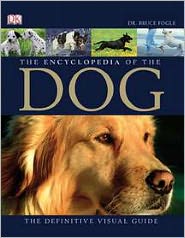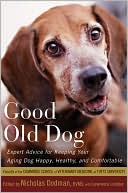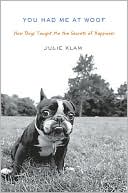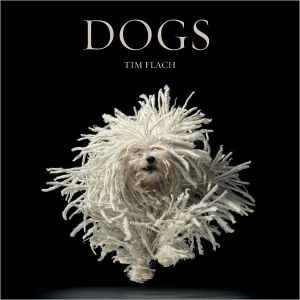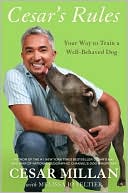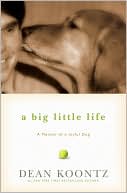The New Encyclopedia of the Dog
Updated with new breeds and new photos!\ With detailed descriptions of more then 420 breeds and varieties of dogs from around the world, an entertaining look at canines throughout history, and invaluable practical advice, The New Encyclopedia of the Dog is the most comprehensive exploration of the canine world ever published.\ Visual Breed Guide: Specially commissioned, full-color photographs bring to life the delightful variety of the canine community. In these pages, you will find not only...
Search in google:
Updated with new breeds and new photos! With detailed descriptions of more then 420 breeds and varieties of dogs from around the world, an entertaining look at canines throughout history, and invaluable practical advice, The New Encyclopedia of the Dog is the most comprehensive exploration of the canine world ever published. Visual Breed Guide: Specially commissioned, full-color photographs bring to life the delightful variety of the canine community. In these pages, you will find not only familiar breeds such as the Labrador Retriever and the Yorkshire Terrier, but also rarities such as the Kyi Leo and the Prazsky Krysavik (the world's smallest dog), as well as experimental crossbreeds like the Labradoodle and Cockerpoo. Each portrait is accompanied by an authoritative biography of the breed, including its place of origin, historical development, main physical features, and temperament. Complete History: From how dogs evolved from wolves, through the story of their domestication by early humans, to their roles today as comforting friends, workers, and companions in sport, Bruce Fogle illuminates why dogs have achieved a place of honor in the human community. He traces the special position of canines in human history, as well as presenting essential practical information on choosing and caring for a dog. His thorough discussions of canine anatomy (illustrated with diagrams and photographs), behavior, and psychology offer insights into the way dogs learn, and how they see the world around them. Fresno Bee You'll use it again and again.
\ \ \ \ \ Introduction\ \ \ For thousands of years the dog's closest relative, the wolf, followed human groups and scavenged from the remains of their kills. However, when our distant ancestors settled into semipermanent homesites, something unique in the history of evolution occurred. One intelligent social carnivore actively chose to live in close proximity to another. So began a fruitful relationship that still exists today. It is so frequently written that it has become a cliché, but it is true — the dog is our best friend. Without its help in protecting campsites, assisting on the hunt, guarding our flocks, and pulling our loads, we probably would not have evolved in the way that we have. It is also unlikely that we would have survived in many parts of the world.\ \ \ A long relationship\ As the most dominant and powerful species in the world, we naturally assume that our ancestors actively chose to domesticate the wolf and create an obedient canine. It is more likely that, like the domestic cat, the dog is self-domesticated, that 1,000 generations ago, its ancestors were adaptable enough to see the advantages of living in the territory that surrounded semipermanent human campsites. The wolf invaded this new ecological niche, and with time its fear and distrust of humans diminished. The relationship began well over 15,000 years ago, and by 12,000 years ago the modified wolf — what we now call the dog — had evolved. Smaller than the wolf, the primitive dog also had a head that was more domed and more puppy-like than that of the wolf, and teeth that were smaller and more crowded. It was more playful,more obedient, and even had a shorter intestinal tract than the wolf.\ \ \ Regional differences\ The relationship we have with dogs varies dramatically and is deeply influenced by cultural perspectives. The ancient Chinese developed profound respect for the dog's abilities. Islam, on the other hand, labeled the dog "unclean," a sensible public health rule in a region where rabies was endemic, but one that has led to a strong distaste for canine companionship in traditional Islamic countries. However, the antiquity and utility of our relationship with the dog predates all modern religions. Although canine companionship is culturally discouraged in many Arab countries, the most ancient racing and hunting dogs, the breeds with the longest pedigrees — the Salukis and Sloughis — are of Arab origin. A similar ambivalent relationship toward the dog exists in the Far East. In Hong Kong, Taiwan, and Singapore, dog ownership is popular and unencumbered by excessive restrictions. In the People's Republic of China, and specifically in Beijing, government authorities use heavy financial penalties to discourage dog ownership. In spite of these obstacles, multitudes still keep canine companions.\ \ \ The dog in society\ Our evolving relationship with the dog can be followed by examining how it is portrayed in folklore and religion, literature, and art. The dog's role in past and present cultures and societies can be surveyed by exploring its involvement in our day-to-day activities — in agriculture, sports, defense, and security. Its roles and activities are many and diverse because its basic physical and psychological design is so superb. Physically, it is a robust carnivore with sophisticated senses, many of which are superior to ours. Its body systems are highly adaptable, permitting it to survive on a varied diet. Most important, when we consider its relationship with us, is its profoundly sociable behavior. Like us, dogs are pack animals. They enjoy company, and because we communicate in ways that they understand, we make acceptable dog substitutes as companions.\ \ \ Variety and function\ The dog is a member of the canine family, or Canidae, and within this family there is a striking size variety, ranging from the tiny Fennec Fox to the massive Canadian Timber Wolf. The domestic dog has inherited the genetic potential to vary between these size extremes, and through our intervention we have produced breeds varying dramatically in size, as well as in other characteristics. Some breeds are described as primitive, although they are really no more ancient than many others. Sighthounds are lean and muscular, with a common origin in dogs that chased game by sight. Scenthounds vary considerably in shape and size, but share a common attribute: a better than average ability to follow both ground and airborne scent trails. Spitz-type dogs have dense coats to protect them from the northern winter climate. Most terriers share common origins as game and vermin hunters, but vary considerably in size, from small, feisty terriers to the long-limbed, large, muscular Airedale. The gundogs are of recent European and American origin, bred to work with hunters. Livestock breeds, created initially to protect and later to drive livestock, are popular worldwide. From the original guarding breeds, war dogs, fighting dogs, and modern security dogs were developed.\ There are over 400 breeds of dogs. Some purebred dogs, and a large proportion of random-bred dogs, have particularly affable personalities and are primarily companions. It is our responsibility to care for them and make sure that their lives are rewarding.\ \ \ The canine-human relationship\ Our relationship with the dog is one of chance. Both of us evolved in different ecological niches, dogs perhaps somewhere in Asia and humans perhaps somewhere in Africa. Both of us migrated from our ancestral homes to other parts of the world. In a minor sense we were competitors for food, but in other aspects of life there was little competition between our two species. Our serendipitous union was mutually beneficial, enabling both species to spread into regions of the world in which neither could survive without the help of the other. It is a fascinating relationship, our most significant alliance with any other mammal, truly beneficial to both parties. What of the future?\ \ \ Selective breeding\ The trend towards keeping purebred (rather than random-bred) dogs as pets is accelerating in the 21st century. In some regions of the world, such as Scandinavia, purebreds now form a significant majority of the dog population. This increasingly rigid management system of dog breeding has both strengths and weaknesses. On the positive side, breeding for size, shape and color also selects for temperament. Labrador Retrievers, for example, are likely to be amenable and responsive to commands, while Jack Russell Terriers are likely to be focused and super-alert. Selectively shopping for purebreds means you can, quite accurately, choose a personality you want to live with. On the negative side, breeding only from within the genetic pool of dogs that share similar size, shape and color characteristics restricts genetic choice and increases the concentration of unwanted, potentially dangerous genes — genes that, for example, increase the risk of disease.\ \ \ Life span facts\ The computerization of breeding and veterinary medical records is producing an explosion of information on the effects of selective breeding. Analyzing records held by Swedish and British pet health insurance companies has produced the first reasonably accurate actuarial statistics on the incidence of disease and life expectancy of different breeds. Life expectancy statistics from Britain show that the median life expectancy of crossbred dogs is 13.2 years.\ It has become clear that some purebreds have shorter life expectancies than those of random-breds. Bernese Mountain Dogs, Bulldogs, and Irish Wolfhounds, for example, have median life expectancies of around seven years. On the other side of the equation, Whippets, Miniature Poodles, Miniature Dachshunds, Bedlington Terriers, and Jack Russell Terriers have median life expectancies of over 14 years.\ \ \ Breed behavior\ While computers generate new information about dogs, it still requires good, old-fashioned observation and interpretation to explain some of these new statistics. For example, computer-generated information confirms what many veterinarians and dog breeders have suspected, that solid-colored Cocker Spaniels, especially golden ones, can experience a condition called sudden rage syndrome, an abrupt Jeckyll-Hyde transformation in personality from benign to aggressive, then back to benign. The statistics are sound, but when scientists at Cambridge University interviewed Cocker Spaniel owners and asked them to complete self-assessment personality questionnaires, they observed that quite consistently, people with low self-esteem were more likely to have aggression problems with their Cockers, regardless of the color of the Cocker's hair. What these scientists showed is that a dog's behavior is influenced by the human family it lives with — not a great surprise to those of us who spend our lives at the interface of that relationship.\ \ \ Genetic studies\ Just as the human genetic map, the human genome, is being scientifically mapped, so too is the canine genome, and already the results are compelling. While the size, shape and temperament of breeds of dog differ considerably, it appears that their genetic map is surprisingly similar — so similar that some scientists now believe the magnificent variety of dogs we have today may well descend from a single family of wolves! From my medical perspective as a practicing veterinarian, genetic studies are starting to reveal the specific genes associated with inherited diseases. One of the first discoveries, in the Irish Setter, was of the gene associated with progressive retinal atrophy (PRA), an inherited form of blindness. Once the genetic cause of a condition is known parents can be checked before breeding, to see whether they carry this gene. New studies of the genetic causes of other canine diseases are published with astonishing frequency.\ \ \ Scientific intervention\ There is a downside. Mapping the causes of disease is welcome, but it is only a matter of time before genetic sequences associated with canine behavior are mapped. What then? The ethics of engineering dogs for physical or mental characteristics will, I regret, have low priority. While we debate the ethics of engineering a future generation of people, dogs will be used to test these new techniques. Cloning procedures, first developed to produce Dolly, a cloned sheep, may be applied to dogs. This may appeal to some owners, anxious to replicate their aging family companion with an identical dog. But we don't know all the consequences. For thousands of generations, we have intervened in dog breeding, deciding who should breed with whom; but nature decided who survived and who did not. In the 21st century, this no longer applies. It may, for example, be possible to insert a gene into dogs that will make it repellent to fleas or non-allergenic to people. The range of possibilities is unending. What is missing is any ethical debate on whether we should be considering these options.
Introduction6 Chapter One Development of the Dog Evolution of the Dog14 Distant Relatives16 Close Relatives18 Chapter Two Dogs and Humans The First Domestic Dogs24 Dogs in Folklore and Religion26 Dogs in Art28 Canine Collectables30 Dogs in Literature32 Dogs on Film34 Dogs in Sports36 Dogs in the Service of Humans38 Dogs as Companions40 Chapter Three Canine Design The Skeleton46 The Brain and Senses48 Nerves, Muscles, and Movement50 The Heart and Lungs52 The Gastrointestinal System54 Urinary and Reproductive Systems56 The Skin and Coat58 Biofeedback60 Chapter Four The Language ofDogs Courtship, Mating, and Birth66 Growing Up68 The Pack70 Aggression and Affection72 Communication74 Chapter Five Domestic Dog Breeds Introduction to Breed Types82 Primitive Dogs84 Sighthounds102 Spitz-Type Dogs118 Scenthounds154 Gundogs202 Terriers252 Livestock and Guarding Dogs300 Companion Dogs362 Random-Bred Dogs392 Chapter Six Caring for Your Dog Choosing a Dog396 Essential Equipment398 Health and Safety400 Feeding and Nutrition402 Grooming404 Traveling and Boarding406 Behavioral Problems408 Glossary410 Index411 Acknowledgments416
\ Boston GlobeHefty and handsome, this book is a must for a dog lover's library.\ \ \ \ \ Carol MemmottFor those who can never get enough canine trivia, the author traces the evolution of dogs from wolves to our domesticated side-kicks. Fascinating facts on dogs in art, literature, folklore and religion abound. The New Encyclopedia of the Dog is the ultimate compendium for serious dog lovers.\ — USA Today\ \ \ Fresno BeeYou'll use it again and again.\ \ \ \ \ House & GardenFogle's compilation is at once lavish and concise.\ \ \ \ \ USA TodayThe ultimate compendium for serious dog lovers.\ \ \ \ \ Library JournalLike the first edition (LJ 9/15/95), this revised version is an exceptional encyclopedic look at over 420 breeds and varieties of dogs. The revised edition boasts 148 new pages of information. About 75 percent of the text is devoted to descriptions and photographs of the dogs themselves. Fogle (The ASPCA Complete Dog Training Manual) uses the same arbitrary categories of the first edition: primitive dogs, sighthounds, spitz-type dogs, scenthounds, gundogs, terriers, livestock and guarding dogs, companion dogs, and random-bred dogs. Fortunately, the very thorough index makes locating a specific type of dog much easier. Most breeds are covered in half- or full-page entries with "key facts" and several excellent photographs. Other chapters cover canine development, dogs and humans, canine design, the language of dogs, and caring for your dog. The subchapters provide only a cursory look at their topics ("Behavioral Problems" takes up only two pages); Fogle has written excellent books that cover these topics in better detail. A glossary is provided, and though many of the definitions are vague or confusing, they do not mar the overall book. Still, an excellent choice for many public libraries, even smaller ones.--Edell M. Schaefer, Brookfield P.L., WI Copyright 2000 Cahners Business Information.\ \
